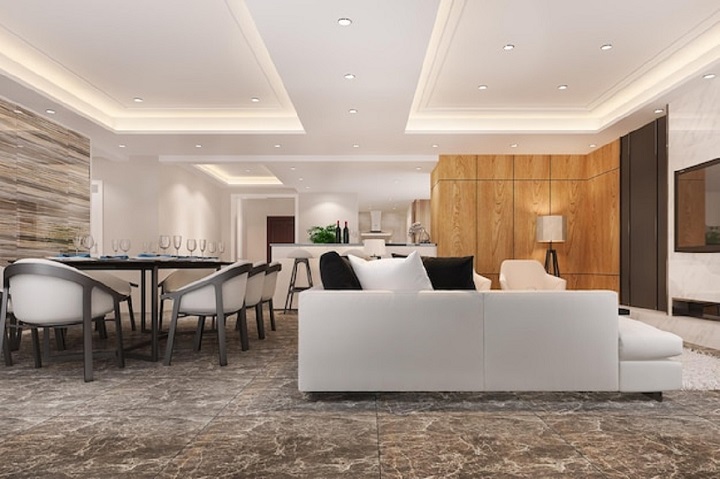More than ever, homeowners are exploring modern home improvement and renovation options that are reliable, cost-effective, and visually stunning. Are you thinking of remodeling your house? Have you thought about PVC ceilings? Yes! PVC, or Polyvinyl Chloride, is steadily gaining popularity as an alternative to traditional ceiling materials. This guide will delve into the nitty-gritty around PVC ceilings, bringing you one step closer to your home improvement goals.
Now, you may wonder, “Why PVC?” or “Isn’t that what they use for pipes? Although PVC is often associated with plumbing, its versatility has allowed it to be applied to a wide range of industries, such as interior design and architecture. Besides their aesthetic appeal, PVC ceilings provide benefits that might just make them the perfect choice for your renovation project. This step-by-step guide will walk you through everything you need to know about them.
What are PVC Ceilings?
Polyvinyl Chloride (PVC) is a robust, lightweight synthetic material. It’s most famous for its use in plumbing, but it’s now also redefining the way we think about home décor. PVC ceilings, available in a variety of designs and finishes, are an increasingly popular choice among homeowners and designers alike – why? We’ll discover this next.
An in-depth guide on installing PVC ceilings provides a comprehensive set of instructions for individuals looking to undertake the installation process. PVC ceilings, or Polyvinyl Chloride ceilings, are a popular choice for their durability, ease of maintenance, and aesthetic appeal.
Here’s a step-by-step description of what such a guide might include:
Introduction to PVC Ceilings:
A brief overview of PVC ceilings and their advantages.
Explanation of why PVC is a suitable material for ceilings.
Materials and Tools:
Detailed list of materials required for the installation.
Comprehensive list of tools needed for the job.
Safety Precautions:
Important safety measures are to be taken during the installation process.
Recommendations for personal protective equipment (PPE).
Preparing the Ceiling Surface:
Inspection of the existing ceiling for any damage or irregularities.
Patching or repairing any imperfections in the ceiling.
Measuring and Marking:
Accurate measurement of the ceiling dimensions.
Marking guidelines for the placement of PVC panels.
Cutting PVC Panels:
Techniques for cutting PVC panels to fit the ceiling dimensions.
Tips for achieving clean and precise cuts.
Installing the Framework:
Creating a stable framework for attaching PVC panels.
Ensuring proper spacing and alignment of the framework.
Attaching the PVC Panels:
Step-by-step instructions for affixing PVC panels to the framework.
Guidance on securing panels for a seamless appearance.
Dealing with Corners and Edges:
Special considerations for installing panels around corners and edges.
Techniques for achieving a professional finish in challenging areas.
Securing Trim and Finishing Touches:
Installing trim pieces to enhance the aesthetic appeal.
Final touches to ensure a polished and completed look.
Maintenance and Cleaning:
Tips for maintaining the cleanliness and longevity of PVC ceilings.
Guidance on proper cleaning methods without causing damage.
Troubleshooting:
Common issues during installation and how to address them.
Solutions for potential challenges that may arise.
Additional Tips and Recommendations:
Suggestions for enhancing the overall installation experience.
Any additional tips or tricks for a successful installation?
Advantages and Drawbacks of PVC Ceilings
Pros and cons are inherent to any product. PVC ceilings are no exception. Gaining a clear understanding of the strengths and weaknesses of PVC ceilings will empower you to make the right decision for your home.
Comparing PVC with Conventional Ceiling Materials
Every material that goes into your renovation has an impact. Here we’ll evaluate PVC ceilings against materials traditionally used for ceilings. We’ll explore factors such as durability, maintenance, aesthetics, and cost.
The Principles of PVC Ceiling Installation
Knowing why and what PVC ceilings are is half the battle. The next crucial step in your renovation journey is understanding the installation process. Here, we’ll discuss the tools you’ll need and provide a comprehensive, step-by-step installation guide.
When and Where to Use PVC Ceilings
Every room in your house serves different purposes, and therefore, has different needs. From the kitchen, prone to steams and spills, to the basement potentially battling dampness, your choice of the ceiling should respond appropriately. We’ll explore the rooms where PVC ceilings shine.
Creating a Perfect Look: Design Hacks for PVC Ceilings
Lastly, while functionality is key, aesthetics is equally important. Your ceiling is an often-overlooked canvas, offering endless design possibilities. We’ll go through a few design hacks to ensure your new PVC ceiling complements and enhances your home’s interior.
Conclusion
Home renovators and DIY enthusiasts, it’s time to break the ceiling – metaphorically, and with style. PVC ceilings, with their multiple advantages – durability, flexibility, cost-effectiveness, and visual appeal – have firmly entered the renovation industry and your homes. As with anything, there are disadvantages too, but understanding these pros and cons will help you make an informed choice.
This guide aims to arm you with everything you need to know about installing PVC ceilings. As we’ve shown you, installing these ceilings is a tangible project even for the novice renovator, transforming your room spectacularly. But remember, your home tells your story, so don’t hesitate to add personal elements while installing a PVC ceiling. From bold color choices to subtle textures, the sky is truly the limit with this versatile material.
In a world that’s rapidly moving towards integrating functionality, affordability, and aesthetics, PVC ceilings could well be the future of interior design. So, dare to explore this contemporary ceiling solution, and who knows? Your home may end up as a beautiful example in our next feature on innovative home improvement projects. Happy renovating!


